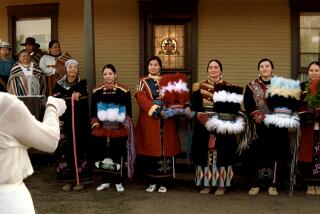Folk Art Unfolds in Amish Quilt Exhibit
- Share via
In 1971, sophisticated art lovers began to yearn for items that could be found only in certain farmhouse bedrooms.
An exhibit of brightly colored, boldly patterned Amish quilts at the Whitney Museum of American Art in New York flabbergasted viewers familiar with the huge canvases of Ellsworth Kelly, Kenneth Noland and other “hard-edge” painters of the 1960s. The Amish, relics of the buggy-and-bonnet age, seemed suddenly to have been airlifted into the 20th Century.
“(The exhibit) expanded the field for quilts . . . it really widened the appreciation for them,” said Elizabeth V. Warren, curator of the Museum of American Folk Art in New York, which has loaned 28 Amish quilts to the Bowers Museum in Santa Ana where they’ll be on display through Mar. 13.
Even with the subdued lighting of the Bowers’ Main Gallery (necessary to keep the dyes from fading), the strict patterns and unusual colors of these wool and cotton textiles from Lancaster and Mifflin counties in Pennsylvania and the Midwest sing out in vivid harmonies.
Sequestered from received notions of which colors do or don’t “go together,” Amish women were free to use whatever combinations struck their fancy. To contemporary eyes, medleys of black, red and gray, black and yellow or pink, maroon and charcoal look anything but folksy.
Although many of the quilt designs (“Sunshine and Shadow,” “Ocean Waves,” “Hole in the Barn Door”) were widely used in America, the Amish versions are distinctive in their strict simplicity.
Geometric shapes--rectangles, squares and triangles--stood in for naturalistic images forbidden by the Amish Ordnung. Big swatches of solid-color cottons and woolens replaced the fancy materials and tiny remnants so proudly pieced together by the non-Amish quilters. Pride in worldly things was not the Amish way.
(A display of 19th-Century American quilts from the Bowers’ own collection, in the Main Gallery corridor, offers a Cook’s tour of patterns, velvets, satins, embroidery, ribbons and other whimsies.)
Although the cheery appliques of their Pennsylvania German neighbors were viewed by the Amish as needless falderal, quilters figured out a way to sneak in additional decoration. Elaborate stitchery designs--justified by their practical role in binding together the quilt tops, filling and bottoms--provided the most subtle of garnishes.
One of the most starkly beautiful of the quilts is a “Plain” variety made of sparing strips of soft blue on gray, with faint gray stitches in patterns known as “feather wreaths.”
A “Bars” quilt from Lancaster County, in red with four vertical yellow stripes enclosed in a blue box, beckons with the bright clarity of an Early American sign. Step up closer and the red border fills with delicate trails of feather stitching.
Gray “stones” tumble decorously over the red diamonds of a “Rolling Stone” quilt from Indiana. Bow-tie shapes flicker over a dark blue “Crosses and Losses” quilt made in Ohio.
The importance of quilts in Amish life remains something of a mystery. “The Amish don’t talk about it,” Warren said. “They don’t have the same historic perspective we do. Their life today is very much as it was when they first came over (from Europe in the 1720s or ‘30s in search of religious tolerance).
“Anything I’m telling you is something I’ve inferred from looking at the quilts, talking to people and just comparing the quilts from different areas.
“To me, the meaning was first of all in the making of them. It played a very important part in the women’s lives. It brought in the planning and the design and creation of them, brought what little bit of art and color and design there was in their lives.
“And getting together with other women in quilting bees played an important psychological role in their lives . . . especially considering that they lived (on widely separated farms) where they didn’t get to interact very often. . . .
“They took pride in what they made as well. To a certain extent, that pride was sinful. But still, there were quilts you’ll see that were never used. Some of these (may have been) ‘best’ quilts reserved to put on beds when church services were held (on a rotating basis) in their homes.”
But, she emphasized, “This is all guesswork on our part. . . . We have to infer based on the fact that so many of these quilts are in pristine condition.”
Nowadays, families tend to preserve their old quilts for special occasions. New quilts generally are made expressly to be sold to dealers. As a result, Warren said, today’s Amish “use whatever comforters they can get at the local store, just to stay warm.”
Amish quilts from the collection of the Museum of American Folk Art are on display through Mar. 13 at the Bowers Museum, 2002 N. Main St., Santa Ana, along with quilts from the Bowers’ own collection. Hours: 10 a.m. to 5 p.m. Tuesdays through Saturdays, noon to 5 p m. Sundays. Admission: free. Information: (714) 972-1900.
More to Read
The biggest entertainment stories
Get our big stories about Hollywood, film, television, music, arts, culture and more right in your inbox as soon as they publish.
You may occasionally receive promotional content from the Los Angeles Times.










